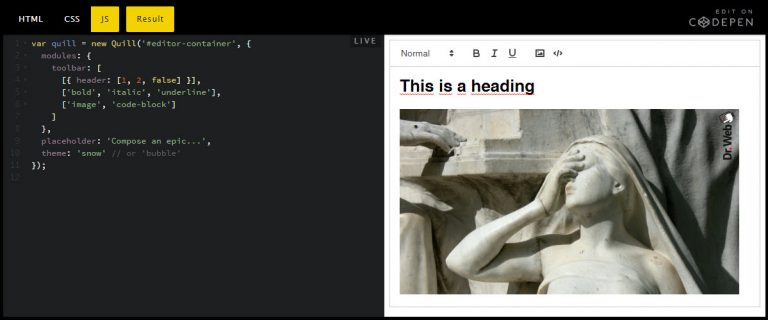The Template Literal, introduced in ES6, is a new way to create a string. With it comes new features that allow us more control over dynamic strings in our programs. Gone will be the days of long string concatenation!
To create a template literal, instead of single quotes (') or double quotes (") quotes we use the backtick (`) character. This will produce a new string, and we can use it in any way we want.
Basic usage:
let newString = `A string`;
Multi-line
The great thing about Template Literals is that we can now create multi-line strings! In the past, if we wanted a string to be on multiple lines, we had to use the n or new line character.
// The old way
var myMultiString = 'Some text that I wantnOn two lines!';
With a Template Literal string, we can just go ahead and add the new line into the string as we write it.
var myMultiString= `This will be
on two lines!`;
This will produce a string with a new line in it. The ability to do this with expressions makes Template Literals a really nice templating language for building of bits of HTML that we will cover later. But what about concatenation? Let’s look at how we can dynamically add values into our new Template Literals.
Expressions
In the new Template Literal syntax we have what are called expressions, and they look like this: ${expression}. Consider the code below.
let name = `Ryan`;
console.log(`Hi my name is ${name}`);
The ${} syntax allows us to put an expression in it and it will produce the value, which in our case above is just a variable that holds a string! There is something to note here: if you wanted to add in values, like above, you do not need to use a Template Literal for the name variable. It could just be a regular string.
console.log(`Hi my name is ${'Ryan'}`);
This will produce the same output. These expressions do more than just let us put in variables that contain strings in them. We can evaluate any sort of expressions that we would like.
let price = 19.99;
let tax = 1.13;
let total = `The total prices is ${price * tax}`;
We can also use this with a more complex object.
let person = {
firstName: `Ryan`,
lastName: `Christiani`,
sayName() {
return `Hi my name is ${this.firstName} ${this.lastName}`;
}
};
Here we have a person object with a sayName() method on it. We can access the properties from an object inside of the ${} syntax.
HTML Templates
With the ability to have multi-line strings and use Template Expressions to add content into our string, this makes it really nice to use for HTML templates in our code.
Let’s imagine that we get some data from an API that looks something like this:
{
"id": 1,
"name": "Bulbasaur",
"base_experience": 64,
"height": 7,
"is_default": true,
"order": 1,
"weight": 69,
...
}
This “imaginary” API is of course the pokeapi! With this data structure in mind, let’s create the markup that would show this Pokemon.
function createMarkup(data) {
return `
<article class="pokemon">
<h3>${data.name}</h3>
<p>The Pokemon ${data.name} has a base experience of ${data.base_experience}, they also weigh ${data.weight}</p>
</article>
`
}
Without having to use a library like Handlebars or Mustache we can create nice and easy-to-use templates in our JavaScript!
Tagged Templates
Another features of Template Literals is the ability to create Tagged Template Literals. You create a function and this function will look like any other function, however it looks different when you call it:
function myTaggedLiteral(strings) {
console.log(strings);
}
myTaggedLiteral`test`;
// ["test"]
Notice there are no parens () when we call the function! We apply a Template Literal where the parentheses would be. As a parameter to our function we get an array of the strings in our literal. Let’s expand on the string we send to the function and we will have it include an expression, and we will include a new parameter in our function as well.
function myTaggedLiteral(strings, value) {
console.log(strings,value);
}
let someText = 'Neat';
myTaggedLiteral`test ${someText}`;
// ["test", ""]
// "Neat"
When we use an expression we can access that from the next parameters and this keeps going. Say we added another expression.
function myTaggedLiteral(strings, value, value2) {
console.log(strings,value);
}
let someText = 'Neat';
myTaggedLiteral`test ${someText} ${2 + 3}`;
// ["test", ""]
// "Neat"
// 5
This is pretty powerful: it allows you to take the data used in a string and manipulate it to your liking.
Reusable Templates
Let’s look at a simple use case for Template Literals. If you remember from above, we saw how Template Literals work really great for, well, making templates! Let’s take that a step further and create a function that would allow us to create reusable templates. The idea here is that we can create the initial template and then pass in data for it to use later.
const student = {
name: "Ryan Christiani",
blogUrl: "http://ryanchristiani.com"
}
const studentTemplate = templater`<article>
<h3>${'name'} is a student at HackerYou</h3>
<p>You can find their work at ${'blogUrl'}.</p>
</article>`;
const myTemplate = studentTemplate(student);
console.log(myTemplate);
// Output will look like this!
// <article>
// <h3>Ryan Christiani is a student at HackerYou</h3>
// <p>You can find their work at http://ryanchristiani.com.</p>
// </article>
Let’s look at implementing our templater function.
const templater = function(strings, ...keys) {
}
The first thing you will notice is this ...keys parameter. The ... syntax is what’s called Rest Parameters; it will gather any parameters the function has and create an array for us.
The next thing we want to do is return a function that is going to access our object. The returning of the function is what allows us to call and pass in our student data, like this: studentTemplate(student).
const templater = function(strings, ...keys) {
return function(data) {
}
}
With this data now available to us we need to perform some manipulation. The process is as follows. First, we need to create a copy of the strings array. We make a copy in case we want to reference the original later. Then we need to loop through the array of keys, and for each one of those, grab the data from the object that matches the key (notice how in this example we pass in a string in the ${}) and place it in our array where needed. Finally, we need to join it all back together as a string and return it from the function!
function templater(strings, ...keys) {
return function(data) {
let temp = strings.slice();
keys.forEach((key, i) => {
temp[i] = temp[i] + data[key];
});
return temp.join('');
}
};
You will notice that this is not an exhaustive example. We have no way to accommodate nested data or array values; it is simply just strings. But I hope this example helps to illustrate what you can start doing with Tagged Template Literals.
Ryan Christiani is the Head Instructor & Development Lead at HackerYou in Toronto and also the author of Let’s Learn ES6, a book with everything you need to know about the latest syntax in JavaScript.
Template Literals is a post from CSS-Tricks






















































